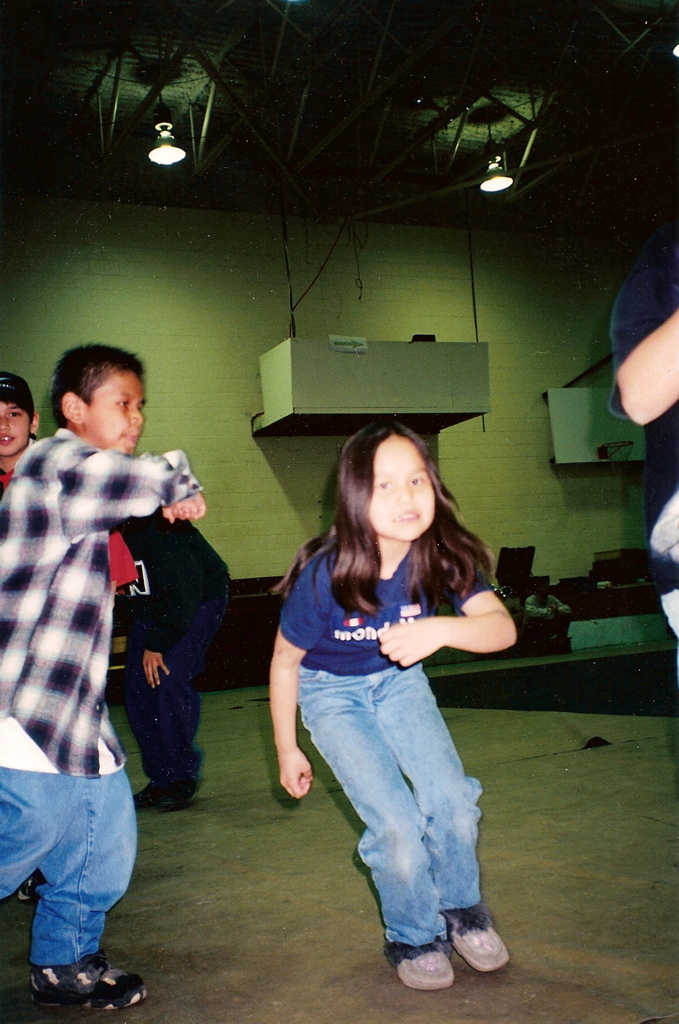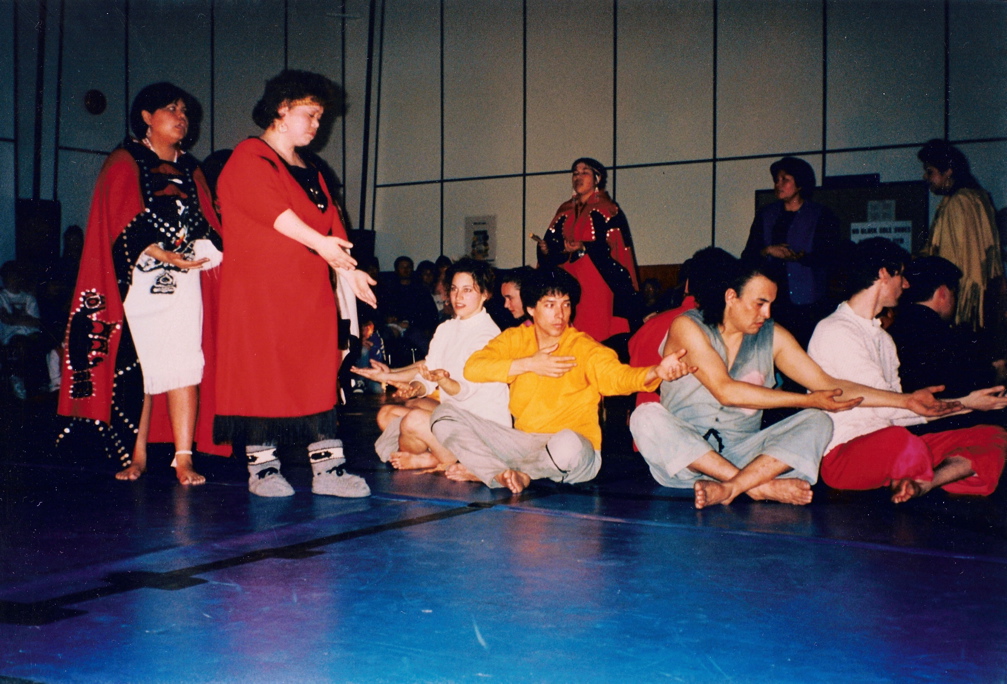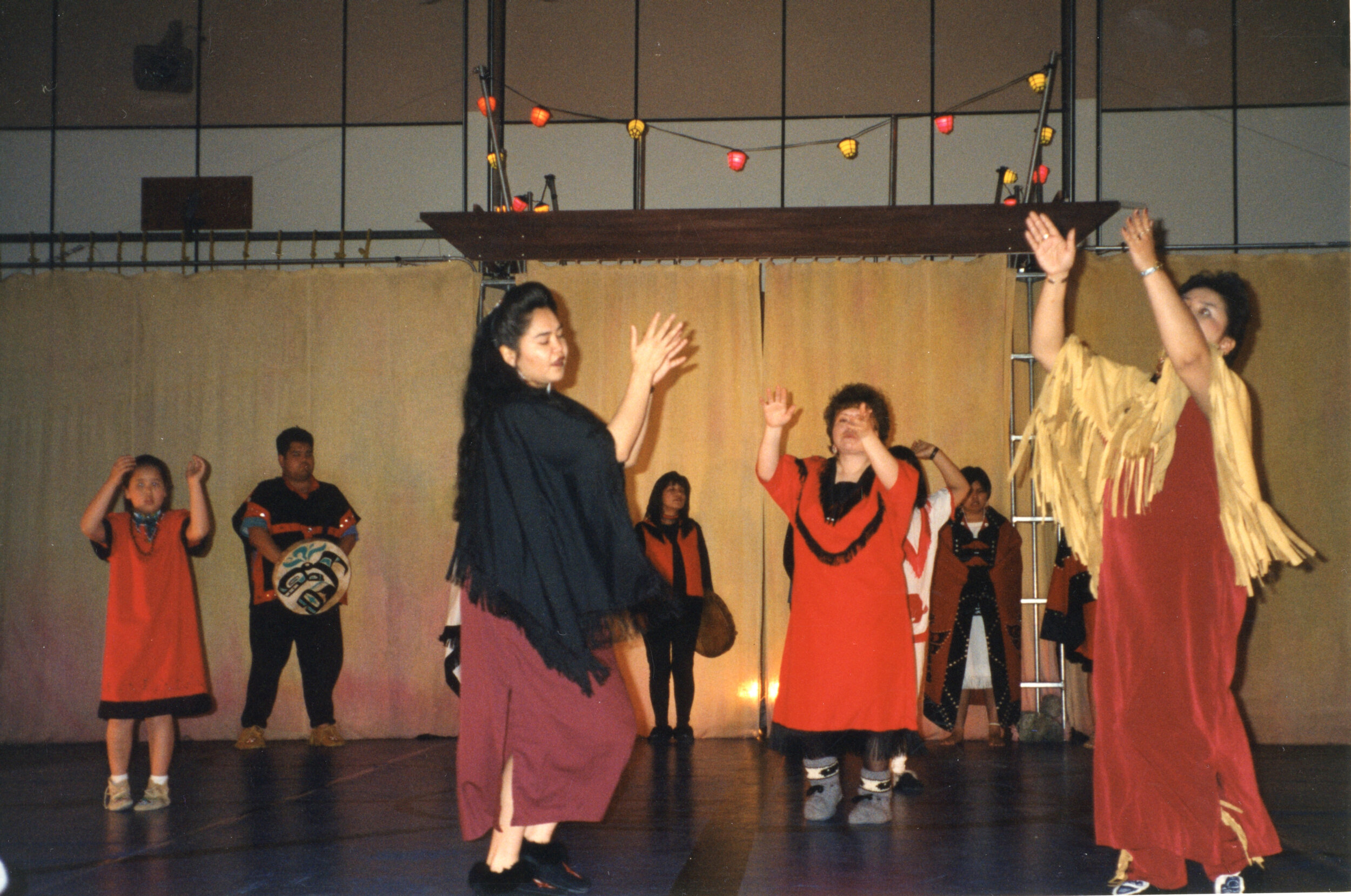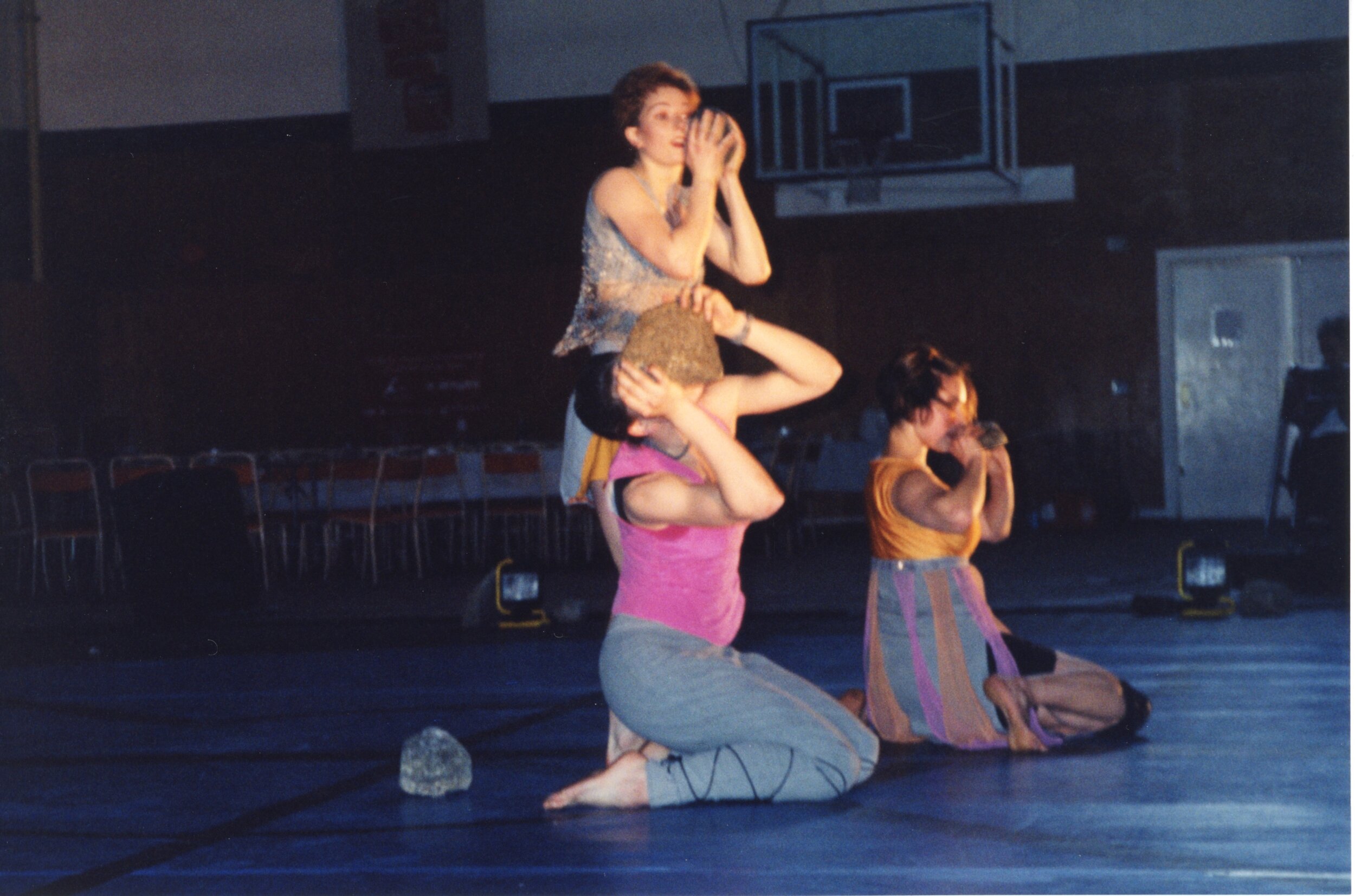Stone Soup (1995-1997)

Stone Soup
1995-1997
About
On April 2, 1997 the Karen Jamieson Dance Company embarked on a five week tour of Northern British Columbia. These performances marked a significant undertaking by all participants – the artists, the company, as well as the local aboriginal and non-aboriginal communities involved in the tour. Stone Soup was presented in the traditional territories of the Wet’suet’en Haisla, Gitk’san, Tsimshian, Nisga’a and Haida Nations.
Underlying and central to Stone Soup is the Gitxsan concept of Gluk: a ceremony of redoing a wrong, as in replacing a rotten plank in the foundation of a structure. Doreen Jensen, Hahl Yee, Gitxsan elder, artist, writer, activist, educator and thinker, as well as a beloved friend and mentor, introduced and proposed the concept to create a dance that would fulfill a Gluk by touring BC asking permission to enter and dance on each of the First Nations territories we came to.
At the beginning of each performance, the members of the Karen Jamieson Dance Company asked people who have an ancestral connection to the land for permission to enter and dance.
The Stone Soup Project was created in a spirit of respect for First Nations people, their traditions and the long-standing relationship of each local native group with the land on which the performance takes place. The tour was welcomed in: Laxgalts’ap, Gitwinksihlkw, Smithers, Terrace, Kitimat, Hazelton, Kispiox, Kitimaat Village, Kemano, Prince Rupert, Masset, Skidegate and ending with a Gala presentation at the Roundhouse Community Centre in Vancouver.
The company attempted, through the performance of Stone Soup, to engage in an activity that builds bridges of understanding between people through the exchange of cultures, in the hope that if we share, we will feast and be richer.
The People
Artistic Director & Choreographer: Karen Jamieson
Dancers: Anne Cooper, Laura Crema, Caroline Farquhar, Karen Jamieson, Donald Alfred Morin, Dean Makarenko, and Jerry Longboat
Composers: Peter Hurst, Simon Kendall
Masks Commission: Sanford Williams
Set & Lighting: Gerald King
Text: Marie Clements
Costume Design: Deborah Dunn
Costume Producer: C. Hatfull
Costume Construction: Alison Abell. Tanya Granneman (Twisted Unions)
Photography: Daniel Collins, Jay Rankin
Managing Director & Producer: Jay Rankin
Company Manager: Kateri Akiwenzie-Damm
Administration: Linda Blankstein, Angela Cormier
Financial Services: Nigel Jones
Rehearsal Directors: Kay Huang Barnes, Andrew Olewine
Dance Teachers: Andrew Olewine, Sylvain Brochu
Accompanist: Patrick Pennefather
Volunteer Coordinator: Mia Kivari
KJD Board: Marsha Ramsden, Sonia Usmiani, Jocelyn Bearsto, Ming Song
Sponsorship Support: Barbara Clausen, Linda Blankstein
Graphics Design: Michela Sorrentino
Tour Publicist: Angele Cormier
Vancouver Publicist: Ryan Mullins
Stage Manager: Ann Rowley
Technical Director: Tim Cardinal
Technician, Set Painting: Lorraine West
Production Assistant: Cameron Rimmer
Program Design: Amanda Marier
Set Construction: Harry Vander Shee, Tradeworks
Set Sewing: Valerie Moffat
REVIEWS
“Audiences were treated to a visually stunning performance Friday by the Karen Jamieson Dance Company... The Tsimshian Nation Cultural Dancers performed first, before the Vancouver company asked permission to perform in traditional Tsimshian territory. The local dance group also closed out the show... It was a fascinating melding of a dance style sculpted over generations and of modern dance.
The costumes, with chain mail vests, capes and men’s waist coats, have hints of the ancient origins of the Stone Soup legend about how an outsider tricks people into sharing their hidden foods.
The sparse yet effective set includes a curtained area. With back-lighting, it allows dance to take place both behind the curtain and in front. Industrial lights around the side of the stage lit the seven dancers who turned a simple children’s morality tale into an hour-long exploration of movement and myth.
Through the dance, accompanied by original music, some text and stylized vocalizations, the audience sees how villagers initially turn a cold shoulder to the outsiders. Their attitude changes to curiosity and finally acceptance – transformations expressed through dance.
The handful of visiting professionals dance in unison and in individual pieces, which expressed the characters’ sentiments towards each other and their possessions. Stones were used not only as the basis for the soup but also metaphorically as the burdens villagers carry, as percussion instruments, and as the food they hide and eventually share.
The Karen Jamieson Dance Company, which has performed here before, brought the Northwest an intense style of modern dance. This is not pretty flouncing about for the sake of being pretty. The movements can be jarring and raw, wild and disturbing as well as subtle, smooth and sensual.
The dance closed out with the symbolic sharing of hot broth, distributed by the dancers to many audience members. Then everyone adjourned to the auditorium for a feast prepared by the Lax Kw’Alaams Society.
Each community on the tour has a meal, feast or potluck to accompany the public performances. From the Nass Valley, the company went to Smithers, Kispiox, Kitsumkalum, Kitamaat Village and Kemano before Rupert, and continues on to Massett and Skidegate.
During each stop in the communities, the group has arranged for school performances – great exposure for the youth of the region to Canadian professional dance.”
- Heather Colpitts
“Intense style of dance tells ancient tale of ‘Stone Soup’”
The Prince Rupert Daily New, April 28, 1997
"For the past 14 years, Jamieson has stood out among west coast choreographers because of her distinctive primal dance style that owes much to her interest in native culture. With her latest show, Stone Soup, she fuses a European folk tale with aboriginal values in an attempt to build a bridge between two cultures…. It is no wonder critics have referred to her as a shaman and a mystic and described her dance as atavistic…. As the dancers tour they ask each community for permission to dance on the land. After Jamieson's troupe performs, local dancers take to the stage and then the community provides a feast for everyone at the show. Aboriginal communities have supported her projects."
- Shannon Rupp
“Making a bridge with stones”
The Globe and Mail, May 10, 1997
"Take one Vancouver-based modern dance company. Add a traditional European legend. Mix with a dozen First Nations dance groups in 29 ceremonial performances across the province, and you have the recipe for the Karen Jamieson Dance Company's five-week Stone Soup tour. Harvey Grant, hereditary chief of the Kitimaat Village Haisla people says ...he was surprised at the hundreds of curious people who showed up for the Kitimaat Village public performance. Most had never seen modern dance before. "I saw our people accept [the dancers] and they watched in awe," he says. "The people that spoke to me after said it was something different from our dance, and that we could learn from each other. This show was well accepted, not only by my people here - the Haisla people - but from what I hear the schoolchildren in Kitimat say, they'd never seen anything like that before."
- Diane Dakers
“A Recipe for Understanding”
“Jamieson’s telling is allusive in the extreme, with seven performers offering up their individual stones to the soup. The stones, as different in shape and size as the dancers who carry them, become something more than chunks of granite.
Jamieson’s dancers use the rocks as counterweights, as anchors, as missiles that carry them from pose to pose. The stones can seem, by turns, like protective blankets, weapons, buoys, pillows, burdens, treasures. Each dancer takes a turn at centre stage before contributing his or her stone to the pot.
The movement surges out of the floor, with bodies pushing upward against invisible limits. Jamieson is at her Grahamesque best in this work, a shadowy figure in a crimson shift and Red Riding Hood cloak, her limbs wildly akimbo.
It isn’t until the singers and dancers of the Musqueam Nation arrive in the second, response part of the evening, that the Stone Soup project makes sense. The great majesty of their chant, honed and polished by centuries of use, is humbling. The paddle song that introduces the Musqueam segment is not meant to be music as spectacle, but a community tool, used to regulate canoe paddlers. The pride and calm, enduring patience of the performers cuts straight to the heart.
A narrative dance complete with clicking, dentalia-shell-encrusted costumes and cedar bark masks, tells the story of a legendary warrior, raised in the deep woods.
The final work is a story chant about three brothers and their long-suffering sister who is so alarmed at how the siblings are mistreating one another that she heads for the hills, where she is transformed into a wolf. And it was Wolf, explained Musqueam performer Ian Campbell, who ‘taught the people how to be a family again.’”
- Michael Scott
“Stone Soup is a tepid recipe for cross-cultural expression”
The Vancouver Sun, May 9, 1997
“When Karen Jamieson took her dance company to Skidegate in the Queen Charlotte Islands last week, she did something few white people have bothered to do in 200 years: she asked permission to be there.
Jamieson and her Vancouver-based troupe have spent a decade exploring the ways that native and non-native culture co-exist. Now she is travelling northern British Columbia with a performance that deals with the arrival of a stranger, and then invites local performers to offer dance works of their own in exchange.
The idea of asking permission to enter communities such as Laxgalt's’ap, Hazelton, Kispiox and Skidegate is a gesture of respect on Jamieson’s part. She has travelled with her company in the north before, in 1992 with a performance called Gawa Gyani that attempted to fuse both native and non-native dance in a single work.
This time Jamieson opts to keep the boundaries, presenting a new work of her own based on a well-known European legend, allowing native groups to perform their own stories and then ending the evening with a communal feast.
‘When you experience the whole evening – when we put into the shared arena our dance and their dance, the this and the that – you see immediately how the whole is greater than its parts,’ Jamieson explains. Normally reserved and even diffident in her speech, Jamieson seems electrified with the success of the Stone Soup project. ‘It is amazing,’ she says. ‘People are seeing Stone Soup as a many-layered metaphor, just as I’d hoped.’”
- Michael Scott
“Dance feeds ideals, culture”
Vancouver Sun, 1997
Please note that populating the Karen Jamieson Dance website with new information and images from the archives is an ongoing process that we are undertaking as fast as we can. Karen Jamieson Dance welcomes any corrections or missing information to the description and acknowledgments listed above. These can be forwarded to admin@kjdance.ca




















